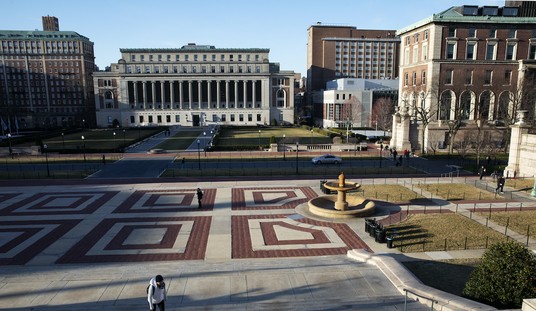Has the cork on the economy finally come unstuck? Or are we on a particularly strong sugar high after two massive stimulus packages in relatively quick succession? It might be tough to distinguish between the two, and to some extent Americans might not care, at least for the moment.
We have two big economic metrics out today, and the flashiest is the weekly initial jobless claims report. After plateauing for months, the level suddenly dropped by almost 200,000 last week, according to the Department of Labor. Only 576,000 Americans applied last week for first-time jobless benefits, the lowest level since the pandemic shutdowns began over a year ago:
In the week ending April 10, the advance figure for seasonally adjusted initial claims was 576,000, a decrease of 193,000 from the previous week’s revised level. This is the lowest level for initial claims since March 14, 2020 when it was 256,000. The previous week’s level was revised up by 25,000 from 744,000 to 769,000. The 4-week moving average was 683,000, a decrease of 47,250 from the previous week’s revised average. This is the lowest level for this average since March 14, 2020 when it was 225,500. The previous week’s average was revised up by 6,500 from 723,750 to 730,250.
The advance seasonally adjusted insured unemployment rate was 2.7 percent for the week ending April 3, an increase of 0.1 percentage point from the previous week’s unrevised rate. The advance number for seasonally adjusted insured unemployment during the week ending April 3 was 3,731,000, an increase of 4,000 from the previous week’s revised level. The previous week’s level was revised down by 7,000 from 3,734,000 to 3,727,000. The 4-week moving average was 3,763,000, a decrease of 98,000 from the previous week’s revised average. This is the lowest level for this average since March 28, 2020 when it was 3,611,750. The previous week’s average was revised down by 1,000 from 3,862,000 to 3,861,000.
Notably, the decline didn’t just take place in the initial claims. The number of Americans on all UI programs, including the special pandemic-relief programs, dropped from 18.2 million to 16.9 million in the final week of March, the latest data for those numbers. Almost all of that decline came in the two pandemic-relief programs. The number itself is still phenomenally high — nearly 17 million workers still drawing relief — but it’s the first major jump in the right direction in a long while, if ever.
This overall result didn’t just beat expectations, it trounced them:
The figure is a 193,000 drop from last week’s surprise spike, suggesting the recovery is trudging onward even as unemployment remains elevated.
Economists had projected about 710,000 fresh claims for the week ending April 10. The week before, some 719,000 Americans applied for unemployment benefits. Though initial jobless claims, a marker for layoffs, remain near historic highs, weekly counts had been trending downward since the beginning of 2021 and in mid-March hit their lowest level since the pandemic began.
It’s remarkable, and in its way feels a little too remarkable. Not to look a gift horse in the mouth, but the correlation to two sudden dumps of government cash seems pretty strong, if not yet the causative case. If it is causative, however, just how sustainable can this be? And if it’s not causative, did we just burn trillions of dollars for nothing, or nothing more than a sugar high?
Today’s retail-sales numbers answers the latter, at least in terms of the personal stimulus checks:
U.S. shoppers boosted retail spending by nearly 10% in March as federal-stimulus funds made their way to households, warmer weather set in and the economy reopened more fully from pandemic-related restrictions.
Retail sales—a measure of purchases at stores, at restaurants and online—jumped 9.8% last month, the Commerce Department reported Thursday. The increase was the largest monthly gain since last May, during the initial bounceback from lockdowns early in the pandemic.
The gain also followed a revised 2.7% drop in sales during February, a level that was slightly better than initially estimated.
Shoppers spent more across several categories, with double-digit gains in sales at restaurants and bars and on clothing, electronics and sporting goods. Spending increased at physical and online stores.
There were also robust gains for sales at auto dealers, amid strong consumer demand for vehicles, and at gas stations, as prices at the pump rose last month.
We could assume that the bounce in retail is attributable to two separate factors: a move toward reopening commerce and the stimulus checks. The former is sustainable, but the latter isn’t. In fact, the drop in February shows just how unsustainable that momentum can be. The more modest $600 per person checks from the late-December stimulus apparently didn’t move the needle on retail for more than a month, likely because it went to covering other expenses left over when effects from the previous stimulus in April of last year ran out. The March stimulus checks allowed for more robust personal consumption expenditures (PCEs) that goosed the economy, but that effect will decline from here on out without other factors.
The reopenings, however, should sustain retail sales going forward. The stimulus checks will create a parallel boost, but states have to allow businesses to reopen to take advantage of the momentum. Once we see those in-person commercial transaction spaces expanding, so too will jobs and with it more spending. At some point, the American economy will have a consumption backlog that should give us a huge growth potential — assuming we don’t dampen it with bad tax policy, of course.
The stimuli provide sugar highs, but it’s the reopenings that will sustain us. That might take longer in the cold-weather north than in the warm-weather south, but hopefully by the end of summer we will have enough Americans vaccinated to end the shutdowns entirely everywhere.








